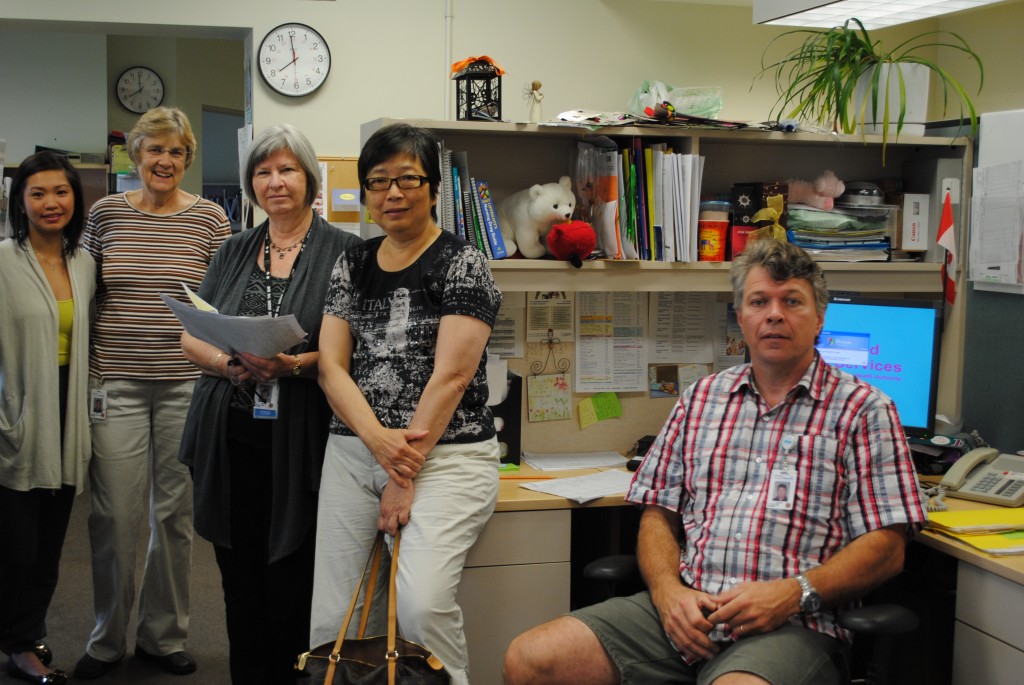Shadowing shines light on ways to improve patients’ experience

Dr. Pat Wong visits with some members of a Richmond homecare team.
Left to right: Camille Coronel (homecare nurse), Martha Ledrew (homecare nurse), Jan Mathewson (clinical coordinator), Dr. Pat Wong (family physician) and Les Boothby (homecare nurse).
While spending a morning with staff in community care, family physician Dr. Patricia Wong saw something very important.
“There are a loft of communications gaps between community care, acute services and GPs,” she says. “They’re not really that connected and they should be.”
Dr. Wong’s half day with community care was part of the bestPATH (Person-centred, Appropriate, Timely, Healthcare) strategy in Richmond focused on improving the care and transition experience for patients and staff.
Bal Sahota and Norm Greenway, clinical nurse educators at Richmond Hospital Home Health and 3S Acute are members of the bestPATH working group. They have indicated that the shadowing initiative created an opportunity to observe and learn from current infrastructures and models of care.
Similarities between two areas
“There are a lot of similarities between community and acute care, but also a lot of confusion around processes and ultimate goals,” Bal says. “We thought it was important to bring some clarity to each other’s roles in order to guide a comprehensive approach to facilitate the best transition for the patient.”
Through this strategy, acute care workers and GPs like Dr. Wong spend face-to-face time with every facet of community care – from intake to home support, attending bed meetings and rounds, witnessing how external referral forms are received and meeting home support workers, home care nurses, occupational therapists, physiotherapists and case managers/social workers.
Staff from community care also spend time shadowing every step in acute care.
“This has offered a glimpse of the full circle of the healthcare journey,” Bal says.
Specifically, the initiative looks at ways of improving patient flow through the healthcare system back into the community in order to enhance patient’s experience and ensure best care, and enhancing processes for staff and physicians. Dr. Wong says she learned two things she did not know before.
“I realized that the waiting list for placement out in the community can be prioritized if there’s a change in their condition,” she says. “I also found out that there are portions of the patients’ journey where they sometimes have to call an answering machine and are put on hold – I don’t think they should have to wait.”
“What we’ve learned in the feedback so far is we need to improve communication between primary, acute and community,” Bal says. “More important is that together we identified a common thread, which is to make sure that we include the client in their plan of care.”
Relationship builder
Overall, the shadowing has shown Bal, Norm and the bestPATH team that orientation to processes and roles in different areas is important in order to promote health and maintain consistency in care for the patients and clients across transition points.
“It allowed us to place a face with the names in 3S and community, making it more comfortable to pick up the phone and call,” Bal says. “It’s about creating closer relationships and understanding each other’s roles within a complex health system.”
“Friendships have even been built with this process, which was a bonus,” she continues. “It’s been a long time thought to build bridges between care environments and bestPath has supported this by allowing healthcare professionals to partner, observe, learn and work together.”
bestPATH is one of several initiatives that fit within VCH’s Home is Best approach to care and service delivery. The approach is based on current evidence that home is the best place for a person to live, as long as they are safely able to do so and they have the appropriate supports.

